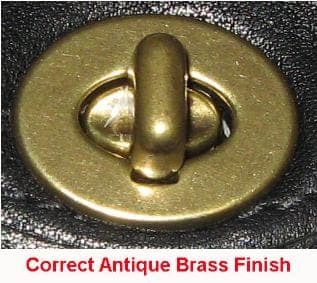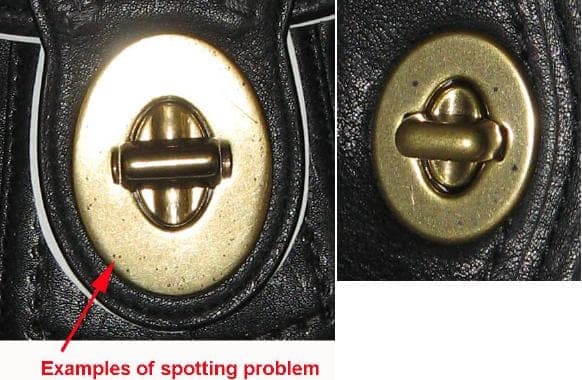
Curated with aloha by
Ted Mooney, P.E. RET

The authoritative public forum
for Metal Finishing 1989-2025

-----
Black spots on Antiqued brass
2007
We are a handbag manufacturer and have been intermittently encountering a spotting issue for approximately the last year or so on an antique brass finish we have been using very heavily in production on our hardware for several years. It looks like little black spots on the surface of the lacquer, sometimes it can be easily rubbed off, other times not and the lacquer is compromised. We have engaged independent laboratories but nevertheless have been unable to positively identify a cause.
The Antique Brass finish we use is achieved by submerging the parts - the vast majority of which are brass-based - in an acid solution (I'm afraid I do not know the specific formula), which leaves them black, and then tumbling off much of the black. Additional details are listed below.
1. Base metal for antique brass application is a copper and zinc blend (brass). It can be forged, stamped or cast.
2. Brass hardware is dipped into an acidic bath batch (copper sulphate
⇦ this on
eBay or
Amazon [affil links] and acids). The viscosity of this batch is controlled by using water.
4. Black coating adhered to the hardware out of the acid bath is removed with an abrasive medium to the desired patina.
5. The hardware is then rinsed with water/solvent (paint thinner/lacquer thinner
⇦ this on
eBay
or
Amazon
[affil links] Warning! highly flammable!
) to remove particulate.
6. Hardware is then oven dried.
6. Lacquer is sprayed onto hardware
Our typical corrosion testing is 48 hours with the part sitting on or affixed to leather, in a covered pan, at 135 °F @ 95% RH.
The spotting issue only occurs on parts that are in contact with leather. Parts tested without leather present do not exhibit the spotting problem.
Whether or not it occurs appears to be sporadic; we have tested two or three bags at a time in the same oven and seen the issue pop up on one bag, but not the other two.
The problem is not isolated to specific suppliers or plating facilities. The brass parts on which the problem occurs are manufactured and finished by a number of unconnected suppliers in Taiwan, China and Korea. Likewise, the leathers involved are of various qualities, in various colors, from various tanneries.
The spotting problem is a fairly recent phenomenon. It initially popped up perhaps a year ago. Prior to that time, we had been using this finish for a few years without ever encountering this type of problem.
We have not encountered this problem with any of our other finishes. Antique Brass is the only one of our widely used finishes to employ the acid solution processing.
Largely because this issue is so recent compared with the length of time the finish has been in use, we have hypothesized that perhaps the chemicals used in the finishing process - principally the acid in the secondary finishing stage - are available only through a very limited number of suppliers, or even a single supplier, and that maybe there has been some fairly recent constitutional change to the acid solution itself that is reacting to leather, which generally has a very high acidic content.
Sorry for the longish letter but we are stumped. Based on this information, does anything leap out at you as a likely culprit? If there is any additional information I can offer by way of clarification, please let me know.


Product Developer - New York, New York
If wrought metal: First neutralize the burnished antique finish in
4 oz/gal baking soda [in bulk on
eBay
or
Amazon [affil links]
, rinse with deionized water, lower the temperature and time in the oven.
If cast, then after finish burnishing, let parts sit in room temp air for three days, then dry scratch brush off the eruptions from the pores in the castings,then lacquer.
If none of the above work, then send raw parts to one of the two prominent suppliers of antiquing chemicals and ask them to specify a process.

Robert H Probert
Robert H Probert Technical Services
Garner, North Carolina

2007
2007
Thanks for the response and suggestions. As most of this product is made in Asia and in mass quantities (hundreds of thousands). We would not be able to hand process the pieces in this way.
Also we have been doing this finish for several years with little issues, so what we are trying to figure out is why is this happening now, what could have possibly changed? We are working with our suppliers on every step of the process to see if we can isolate a raw material or process that could be causing this. Has anyone else out there been experiencing similar issues?
If anyone has any more suggestions, please advise, thanks.
- New York, New York
2007
you should start from:
1. any copper plating supplier change? (according to your e-mail, you have)
2. any leather supplier changes?
then from these suppliers change (or not), try to find out:
1. any process change from the supplier? let's say from copper cyanide to acid copper? It applies to leather supplier too.
It maybe too tedious, and probably at the end you could not figure it out at all, but now you have to do so.
for plating, there are standards for corrosion test, I am not familiar with the leather manufacturing,though, It should be standards there too.
It seems to me that in your case, there maybe sulfur from leather to cause it.
- singapore
Q, A, or Comment on THIS thread -or- Start a NEW Thread